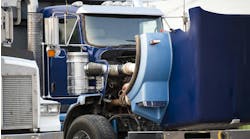Refuse collection in the residential neighborhoods of southern Oregon is fast and efficient for Rogue Disposal and Recycling, a private company that's been using Heil STARR system automated side-loaders in its fleet for many years. Now in its 70th year in business, the company provides residential, commercial and industrial solid waste collection services for nearly 40,000 customers in the greater Medford, OR, area.
Wendel Smith, general manager for Rogue, says, “We do all kinds of things, including collecting recyclables and yard debris for residential customers and collecting hazardous materials like medical waste from commercial clients.”
The fleet consists of 18 pieces of equipment, 15 of which are Heil STARR units. Unlike straight-frame refuse trucks, the tractor-trailer configuration of the Heil system affords it excellent maneuverability on tight city streets. The STARR arm is mounted on the chassis behind the cab and the packing bodies are on detachable trailers, which are available in 33- and 37-cu.-yd. capacities.
The versatile units, Smith notes, provide a safer environment for the company's 49 drivers, allowing them to negotiate dead-ends, cul-de-sacs and other tight spots easily, without constantly backing up. Rogue, he adds, uses the 37-cu.-yd. trailer, which saves wear and tear on the bodies because they don't have to be packed-out in order to get the same capacity as a smaller trailer. With the fleet doing 900 to 1,100 stops per day, wear on the equipment is a big consideration.
According to Smith, the Heil STARR units have worked out very well. “I still have my first unit — a 1997 model,” he reports. The STARR systems are spec'd on right-hand-drive Autocar chassis powered primarily by Cummins ISM and ISL engines rated 300 to 315 hp. and Allison automatic transmissions.
Rogue Disposal and Recycling also specs Toyo and Bridgestone tires with rubber compounds designed for the company's high stop/start, twist/turn application. “Our automated trucks don't go off-road,” Smith advises. “They are driven to transfer stations and loads are dumped on concrete floors. We want to keep them on the road picking up trash, not traveling to landfills, risking broken axles and such.”
Smith says Rogue is also testing out a new prototype arm on a STARR unit they took delivery of last November. “An upgrade to Heil's original Rapid Rail automated arm system, it's stronger, works more smoothly and we think it's going to be more durable over the long run. In addition, we're finding it's going to be easier to work on from a maintenance standpoint.”
Rogue has a large on-site maintenance division to take care of all its equipment, with six full-time mechanics fully trained on the Heil STARR system. PMs are done every 200 hours of operation and complete certifications are done about once a year, Smith says, so they don't have to worry about trucks breaking down in the field.
“Plus, we're one of a few companies that performs a magna flux on our front ends every five years, checking control arms, spindles, etc. The ‘wet mag’ procedure can detect cracks not visible to the naked eye, allowing us to replace parts before they become safety issues,” Smith states.
Another area Rogue has been very proactive in is reducing emissions levels. It's of particular concern living and working in southern Oregon, Smith points out, where particulate matter and carbon monoxide levels tend to be high because of the constraints of the mountains surrounding them.
In 2003, Rogue started working toward lowering emissions levels in its fleet. The company applied to programs like CMAQ (Congestion Mitigation and Air Quality improvement program) and began working with Cummins to install exhaust aftertreatment devices on its truck. “Through those efforts we've able to reduce emissions on nearly half our fleet by 50%,” he reports. “So far we've retrofitted about nine of our refuse trucks with the diesel particulate removers (DPRs) and we expect to add nine more soon.”


